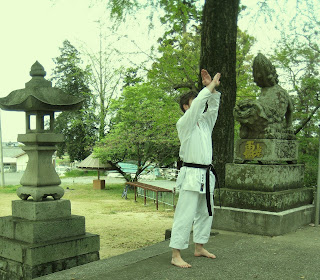 The Nakatsu JKS (Japan Karate Shotorenmei) Seminars held between May 2nd and May 4th were nothing less than fantastic. I’m very thankful to Tachibana Shihan (8th Dan) and JKS Oita-ken for inviting me to this event held at the Renshinkan, very close to Nakatsu castle. As usual, Tachibana Shihan gave world class karate tuition, making sure that every karateka in attendance further polished their skills. Here is a general summary of the course.
The Nakatsu JKS (Japan Karate Shotorenmei) Seminars held between May 2nd and May 4th were nothing less than fantastic. I’m very thankful to Tachibana Shihan (8th Dan) and JKS Oita-ken for inviting me to this event held at the Renshinkan, very close to Nakatsu castle. As usual, Tachibana Shihan gave world class karate tuition, making sure that every karateka in attendance further polished their skills. Here is a general summary of the course.
_________
The schedule: The training sessions were as follows: Saturday and Sunday practice both started at 10am and concluded at 3pm. The Sunday session began at 10am and finished at midday. The first day was focused primarily on kihon and kumite; the second day, mainly kata; and the final day, just two of the sentei kata.
________
Kihon:

We did lots of stationary kihon and ido-kihon, however, the majority of ‘basics’ done throughout this course were executed from the freestyle position. Core fundamental techniques were repeated over and over again. Renzokuwaza such as kizami zuki kara gyaku zuki, mae ashi mae geri kara mae geri, and the grading curriculum kihon were typical. The underlying message was “High repetitions of exact techniques are necessary to achieve consistent excellence”. One general theme emphasized by Shihan throughout the course was the maintenance of exact posture at all times, and long extension, especially in punching attacks. In particular, this was related to the ‘kumite focused’ Junro kata. Supplementing (and alongside) the kihon, (and in addition to the 'traditional morning run' and cleaning each day) we did a fair amount of karate-specific endurance/conditioning exercises, such as squat thrusts, pushups, sit ups, all types of jumps, leg raises and so forth.
Kata
The second day of the course featured the most variety of kata. Those covered included Heian-shodan, Heian-nidan and Heian-sandan; Junro-shodan, Junro-nidan and Junro-sandan; Joko-issei, Joko-nisei and Joko-sansei; Tekki-shodan, Kibaken and Jion. And some very interesting and complex variations were taught! The two hour practice on Monday morning (for dan grades only

) was totally focused on Bassai-dai and Kanku-dai in isolation. I was honored that Tachibana Shihan had me teach that lesson.
KumiteOne special point about this course was the high focus on kumite, which goes without saying, I really enjoyed. We covered all of the ‘standard forms’ of examination kumite (Sanbon kumite, Gohon kumite, Kihon ippon kumite, Jiyu ippon kumite and Jiyu kumite). We also did many variations of these, for example:
(a) Godan kumite: Sanbon jodan zuki on each step (second punch blocked with gyaku jodan age-uke). Final step counter with gyaku zuki followed by mae ashi mawashi geri kara gyaku zuki, then ura mawashi geri kara gyaku zuki;
(b) Gohon kumite: Tobi konde oi zuki kara mae geri (defend with age-uke in the usual manner followed by yori-ashi rearward with gedan-barai and hangeiki);
(c) Kihon ippon kumite: Attacker advances with tobi konde jodan oi zuki and defender collides with tobi konde jodan age uke followed by an appropriate hangeiki-waza etc... Simple, yes! Easy, no! Well at least not for me… All of this led to some jiyu ippon kumite, and an ample amount of jiyu kumite. One personal highlight was getting to do jiy

u-kumite against multiple opponents, something I haven’t done for a few years.
I’ll wrap up by once again offering my sincere thanks to JKS Oita-ken Chief Instructor, Tachibana Shihan, for his brilliant karate training, and also to the other students who I sweated alongside with at the seminar. Arigato gozaimazu. Osu! André
_________
© André Bertel, Japan
2009
 I am a very confident person in my life, but when it comes to my karate technique, I’m never happy with myself – never satisfied. That is the reason I’m so confident in my life outside of the dojo, and this is how karate-do builds its followers into stronger human beings. Karate training knocks us down, as it forces us to mercilessly face our weaknesses, and no matter how much we technically improve, we find more flaws… Unlike our lives, karate is never ending, therefore it serves as a vehicle to improve ourselves throughout our lifetime, hence it is ‘lifetime budo’.
I am a very confident person in my life, but when it comes to my karate technique, I’m never happy with myself – never satisfied. That is the reason I’m so confident in my life outside of the dojo, and this is how karate-do builds its followers into stronger human beings. Karate training knocks us down, as it forces us to mercilessly face our weaknesses, and no matter how much we technically improve, we find more flaws… Unlike our lives, karate is never ending, therefore it serves as a vehicle to improve ourselves throughout our lifetime, hence it is ‘lifetime budo’. How can a karateka, who is always seeking to improve, be or become arrogant? Well quite obviously, they can never be arrogant, and if they are and wish to keep progressing technically, they need to foster humility. That is, they must be, or become, legitimately confident in themselves.
How can a karateka, who is always seeking to improve, be or become arrogant? Well quite obviously, they can never be arrogant, and if they are and wish to keep progressing technically, they need to foster humility. That is, they must be, or become, legitimately confident in themselves.











